Regulation of Fibroblast Cell Polarity by Src Tyrosine Kinase
- PMID: 33535441
- PMCID: PMC7912711
- DOI: 10.3390/biomedicines9020135
Regulation of Fibroblast Cell Polarity by Src Tyrosine Kinase
Abstract
Src protein tyrosine kinases (SFKs) are a family of nonreceptor tyrosine kinases that are localized beneath the plasma membrane and are activated during cell adhesion, migration, and elongation. Due to their involvement in the activation of signal transduction cascades, SFKs have been suggested to play important roles in the determination of cell polarity during cell extension and elongation. However, the mechanism underlying Src-mediated polarity formation remains unclear. The present study was performed to investigate the mechanisms underlying Src-induced cell polarity formation and cell elongation using Src knockout fibroblasts (SYFs) together with an inhibitor of Src. Normal and Src knockout fibroblasts were also transfected with a wild-type c-Src, dominant negative c-Src, or constitutively active c-Src gene to analyze the changes in cell morphology. SYF cells cultured on a glass substrate elongated symmetrically into spindle-shaped cells, with the formation of focal adhesions at both ends of the cells. When normal fibroblasts were treated with Src Inhibitor No. 5, a selective inhibitor of Src tyrosine kinases, they elongated into symmetrical spindle-shaped cells, similar to SYF cells. These results suggest that cell polarity during extension and elongation may be regulated by SFKs and that the expression and regulation of Src are important for the formation of polarity during cell elongation.
Keywords: SFK; c-Src; cell adhesion; cell motility; polarity.
Conflict of interest statement
The authors declare no conflict of interest.
Figures

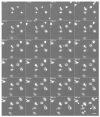
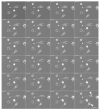
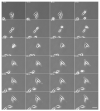
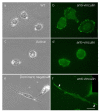
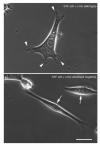

Similar articles
-
Src family kinases are required for integrin but not PDGFR signal transduction.EMBO J. 1999 May 4;18(9):2459-71. doi: 10.1093/emboj/18.9.2459. EMBO J. 1999. PMID: 10228160 Free PMC article.
-
Src family kinase-independent signal transduction and gene induction by leukemia inhibitory factor.J Biol Chem. 2003 Jul 25;278(30):27750-7. doi: 10.1074/jbc.M303670200. Epub 2003 May 21. J Biol Chem. 2003. PMID: 12764151
-
FAK-Dependent Cell Motility and Cell Elongation.Cells. 2020 Jan 12;9(1):192. doi: 10.3390/cells9010192. Cells. 2020. PMID: 31940873 Free PMC article. Review.
-
Integrin-induced tyrosine phosphorylation of protein-tyrosine phosphatase-alpha is required for cytoskeletal reorganization and cell migration.J Biol Chem. 2006 Apr 28;281(17):11972-80. doi: 10.1074/jbc.M600561200. Epub 2006 Feb 28. J Biol Chem. 2006. PMID: 16507567
-
C-terminal Src kinase (CSK) and CSK-homologous kinase (CHK)--endogenous negative regulators of Src-family protein kinases.Growth Factors. 2005 Sep;23(3):233-44. doi: 10.1080/08977190500178877. Growth Factors. 2005. PMID: 16243715 Review.
Cited by
-
Effects of Electrical Stimulation on the Signal Transduction-Related Proteins, c-Src and Focal Adhesion Kinase, in Fibroblasts.Life (Basel). 2022 Apr 4;12(4):531. doi: 10.3390/life12040531. Life (Basel). 2022. PMID: 35455022 Free PMC article.
-
Effects of Electrical Stimulation of the Cell: Wound Healing, Cell Proliferation, Apoptosis, and Signal Transduction.Med Sci (Basel). 2023 Jan 17;11(1):11. doi: 10.3390/medsci11010011. Med Sci (Basel). 2023. PMID: 36810478 Free PMC article.
-
FAK in Cancer: From Mechanisms to Therapeutic Strategies.Int J Mol Sci. 2022 Feb 2;23(3):1726. doi: 10.3390/ijms23031726. Int J Mol Sci. 2022. PMID: 35163650 Free PMC article. Review.
-
Plectin promotes tumor formation by B16 mouse melanoma cells via regulation of Rous sarcoma oncogene activity.BMC Cancer. 2022 Aug 30;22(1):936. doi: 10.1186/s12885-022-10033-4. BMC Cancer. 2022. PMID: 36038818 Free PMC article.
References
-
- Katoh K., Kano Y., Fujiwara K. Isolation and in vitro contraction of stress fibers. Methods Enzymol. 2000;325:369–380. - PubMed
LinkOut - more resources
Full Text Sources
Other Literature Sources
Miscellaneous

